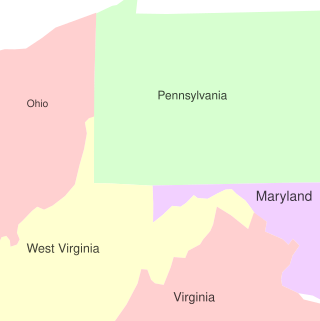
Dynegy Inc. is an electric company based in Houston, Texas. It owns and operates a number of power stations in the U.S., all of which are natural gas-fueled or coal-fueled. Dynegy was acquired by Vistra Corp on April 9, 2018. The company is located at 601 Travis Street in Downtown Houston. The company was founded in 1984 as Natural Gas Clearinghouse. It was originally an energy brokerage, buying and selling natural gas supplies. It changed its name to NGC Corporation in 1995 after entering the electrical power generation business.

Flue-gas desulfurization (FGD) is a set of technologies used to remove sulfur dioxide from exhaust flue gases of fossil-fuel power plants, and from the emissions of other sulfur oxide emitting processes such as waste incineration, petroleum refineries, cement and lime kilns.

A fossil fuel power station is a thermal power station which burns a fossil fuel, such as coal or natural gas, to produce electricity. Fossil fuel power stations have machinery to convert the heat energy of combustion into mechanical energy, which then operates an electrical generator. The prime mover may be a steam turbine, a gas turbine or, in small plants, a reciprocating gas engine. All plants use the energy extracted from the expansion of a hot gas, either steam or combustion gases. Although different energy conversion methods exist, all thermal power station conversion methods have their efficiency limited by the Carnot efficiency and therefore produce waste heat.
Scrubber systems are a diverse group of air pollution control devices that can be used to remove some particulates and/or gases from industrial exhaust streams. An early application of a carbon dioxide scrubber was in the submarine the Ictíneo I, in 1859; a role for which they continue to be used today. Traditionally, the term "scrubber" has referred to pollution control devices that use liquid to wash unwanted pollutants from a gas stream. Recently, the term has also been used to describe systems that inject a dry reagent or slurry into a dirty exhaust stream to "wash out" acid gases. Scrubbers are one of the primary devices that control gaseous emissions, especially acid gases. Scrubbers can also be used for heat recovery from hot gases by flue-gas condensation. They are also used for the high flows in solar, PV, or LED processes.

Coal Pollution Mitigation, sometimes also known as Clean Coal, is a series of systems and technologies that seek to mitigate health and environmental impact of coal; in particular air pollution from coal-fired power stations, and from coal burnt by heavy industry. Clean Coal primarily focuses on removing sulfur dioxide (SO2) and nitrogen oxides (NOx), the most important gasses which cause acid rain; and particulates which cause visible air pollution, illness, and premature deaths. It also reduces fly ash and reduces emissions of radioactive materials. Mercury emissions can be reduced up to 95%. Capturing carbon dioxide emissions from coal is also being pursued.

Allegheny Energy was an electric utility headquartered in Greensburg, Pennsylvania. It owned and operated electric generation facilities and delivered electric services to customers in Pennsylvania, West Virginia, Maryland, and Virginia. Allegheny Energy was incorporated in Maryland in 1925 as West Penn Electric Company. One of its predecessor companies dates back to the formation of West Penn Power on January 31, 1907.

Ameren Corporation is an American power company created December 31, 1997, by the merger of St. Louis, Missouri's Union Electric Company and the neighboring Central Illinois Public Service Company of Springfield, Illinois. It is now a holding company for several power companies and energy companies. The company is based in St. Louis, serving 2.4 million electric, and 900,000 natural gas customers across 64,000 square miles in central and eastern Missouri and the southern four-fifths of Illinois by area.

Homer City Generating Station is a decommissioned 2-GW coal-burning power station near Homer City, in Indiana County, Pennsylvania, USA. It is owned by hedge funds and private equity firms and is operated by NRG Energy. Units 1 and 2, rated at 660 MWe, began operation in 1969. Unit 3, rated at 692 MWe nameplate capacity, was launched in 1977. It employed about 124 people.

The William H. Zimmer Power Station, located near Moscow, Ohio, was a 1.35-gigawatt coal power plant. Planned by Cincinnati Gas and Electric (CG&E), with Columbus & Southern Ohio Electric and Dayton Power & Light (DP&L) as its partners, it was originally intended to be a nuclear power plant. Although once estimated to be 97% complete, poor construction and quality assurance (QA) led to the plant being converted to coal-fired generation. The plant began operations in 1991. Today, the plant is owned and operated by Vistra Corp.

Kyger Creek Power Plant is a 1.08-gigawatt, 1,086 (MW) coal-fired power station located south of Cheshire, Ohio in Gallia County, Ohio. It is operated by the Ohio Valley Electric Corporation (OVEC).

Clifty Creek Power Plant is a 1,300-MW coal-fired power station located in Madison, Indiana. Clifty Creek is operated by the Indiana Kentucky Electric Corporation. It is named after Clifty Creek, which enters the Ohio River nearby.
The Acid Rain Program is a market-based initiative taken by the United States Environmental Protection Agency in an effort to reduce overall atmospheric levels of sulfur dioxide and nitrogen oxides, which cause acid rain. The program is an implementation of emissions trading that primarily targets coal-burning power plants, allowing them to buy and sell emission permits according to individual needs and costs. In 2011, the trading program that existed since 1995 was supplemented by four separate trading programs under the Cross-State Air Pollution Rule (CSAPR). On August 21, 2012, the United States Court of Appeals for the District of Columbia issued its Opinion and Order in the appeal of the Cross State Air Pollution Rule (CSAPR) for two independent legal reasons. The stay on CSAPR was lifted in October 2014, allowing implementation of the law and its trading programs to begin.

A coal-fired power station or coal power plant is a thermal power station which burns coal to generate electricity. Worldwide there are over 2,400 coal-fired power stations, totaling over 2,000 gigawatts capacity. They generate about a third of the world's electricity, but cause many illnesses and the most early deaths, mainly from air pollution.

The Miami Fort Generating Station is a dual-fuel power generating facility. It is a major coal-fired electrical power station, supplemented with a small oil-fired facility. Miami Fort is located in Miami Township, Hamilton County, immediately east of the tripoint of Indiana, Kentucky, and Ohio. Miami Fort Station is named for the nearby Miami Fort.

Brunner Island Steam Electric Station is a coal-fired, alternatively natural gas-powered electrical generation facility in York County, Pennsylvania. It occupies most of the area of the eponymous island on Susquehanna River. The power plant has three major units, which came online in 1961, 1965, and 1969, with respective generating capacities of 334 MW, 390 MW, and 759 MW. In addition, three internal combustion generators were installed in 1967. Talen Energy will stop coal use at the plant in 2028.
Prairie State Energy Campus is a 1,600 megawatt base load, coal-fired, electrical power station and coal mine near Marissa, Illinois, southeast of St. Louis, Missouri. Prairie State Energy Campus (PSEC) features low levels of regulated emissions compared to other coal-fired power stations, capturing sulfur from high-sulfur coal mined nearby instead of transporting low-sulfur coal from elsewhere.
R.E. Burger Power Station was a 568 megawatt (MW), coal power plant located south of Shadyside, Ohio in Belmont County, Ohio. The plant closed in 2011. It was operated by FirstEnergy.

Conesville Power Plant was a 2-gigwatt, coal power plant located east of Conesville, Ohio in Coshocton County, Ohio. Its units were co-owned at the time of its closing by American Electric Power (AEP) and AES Ohio Generation. All plant operations were handled by AEP. Conesville began operations in 1957 and ceased generation in April 2020.

Prairie Rivers Network (PRN) is a non-profit organization, located in Champaign, Illinois. Their work goes on throughout Illinois as an independent, state affiliate of the National Wildlife Federation. The organization describes its mission: "Using the creative power of science, law, and collective action, we protect and restore our rivers, return healthy soils and diverse wildlife to our lands, and transform how we care for the earth and for each other. We protect water, heal land, and inspire change."

The E.D. Edwards Power Plant is an inoperative coal-fired generating plant owned by Vistra Energy. The plant, with a nameplate capacity of 780 megawatts, was connected with the high-tension power supply lines of Central Illinois. It is located on the Illinois River and the Union Pacific Railroad, adjacent to the municipality of Bartonville.
















